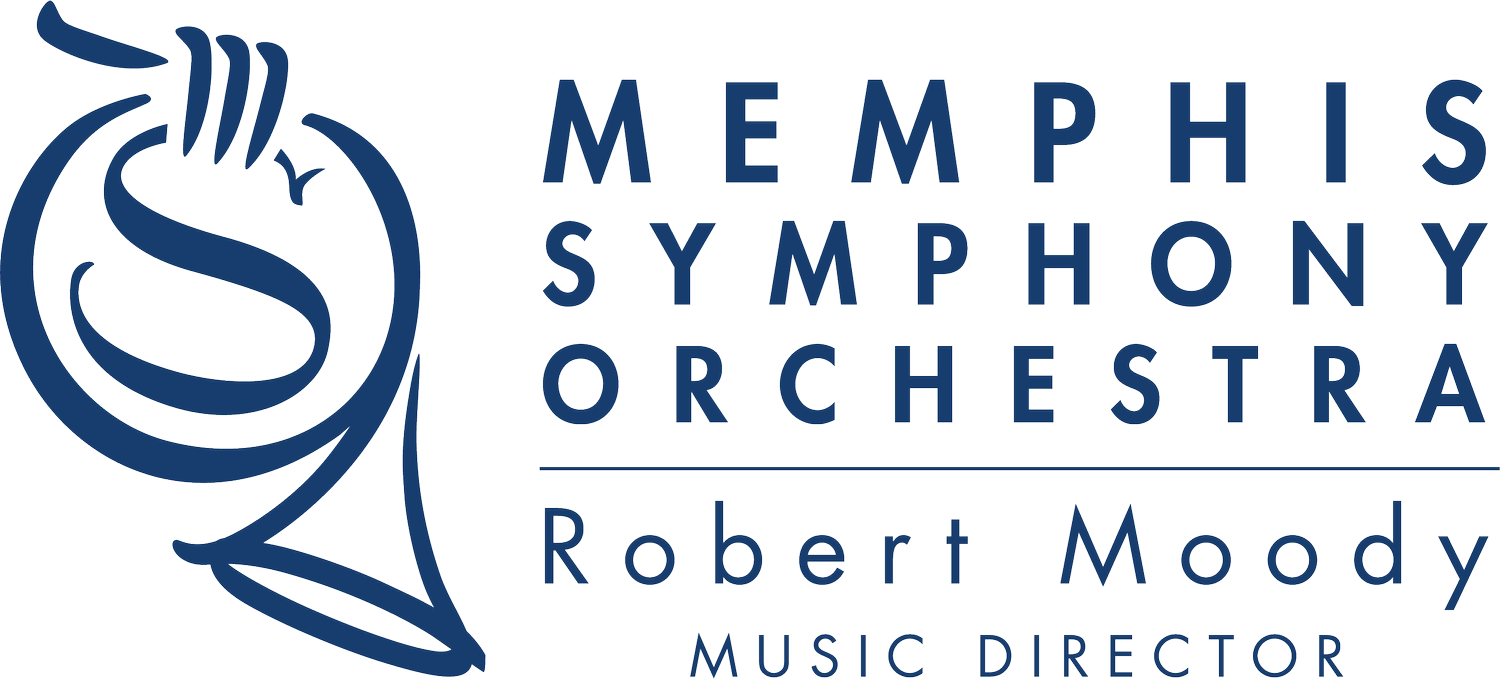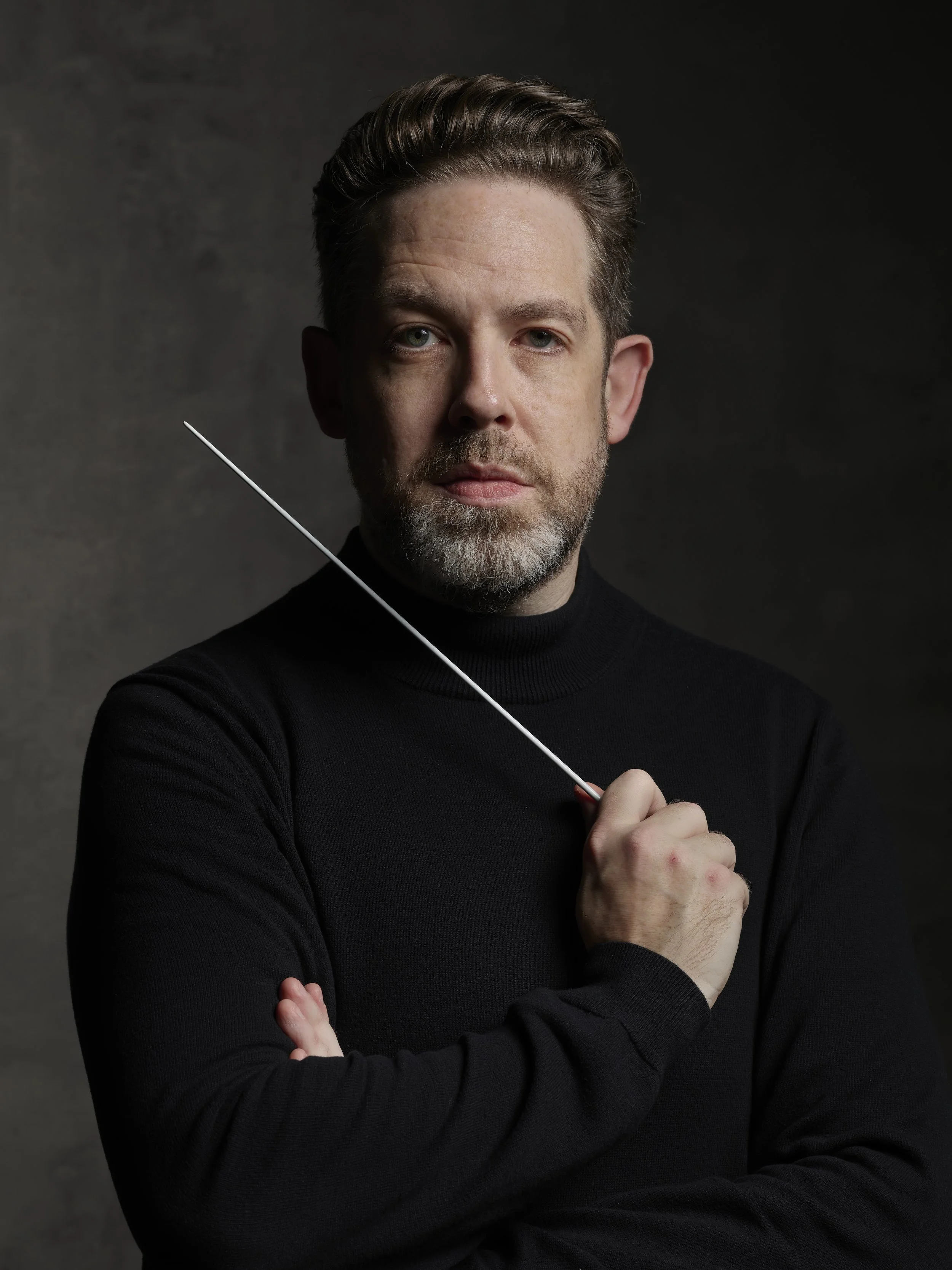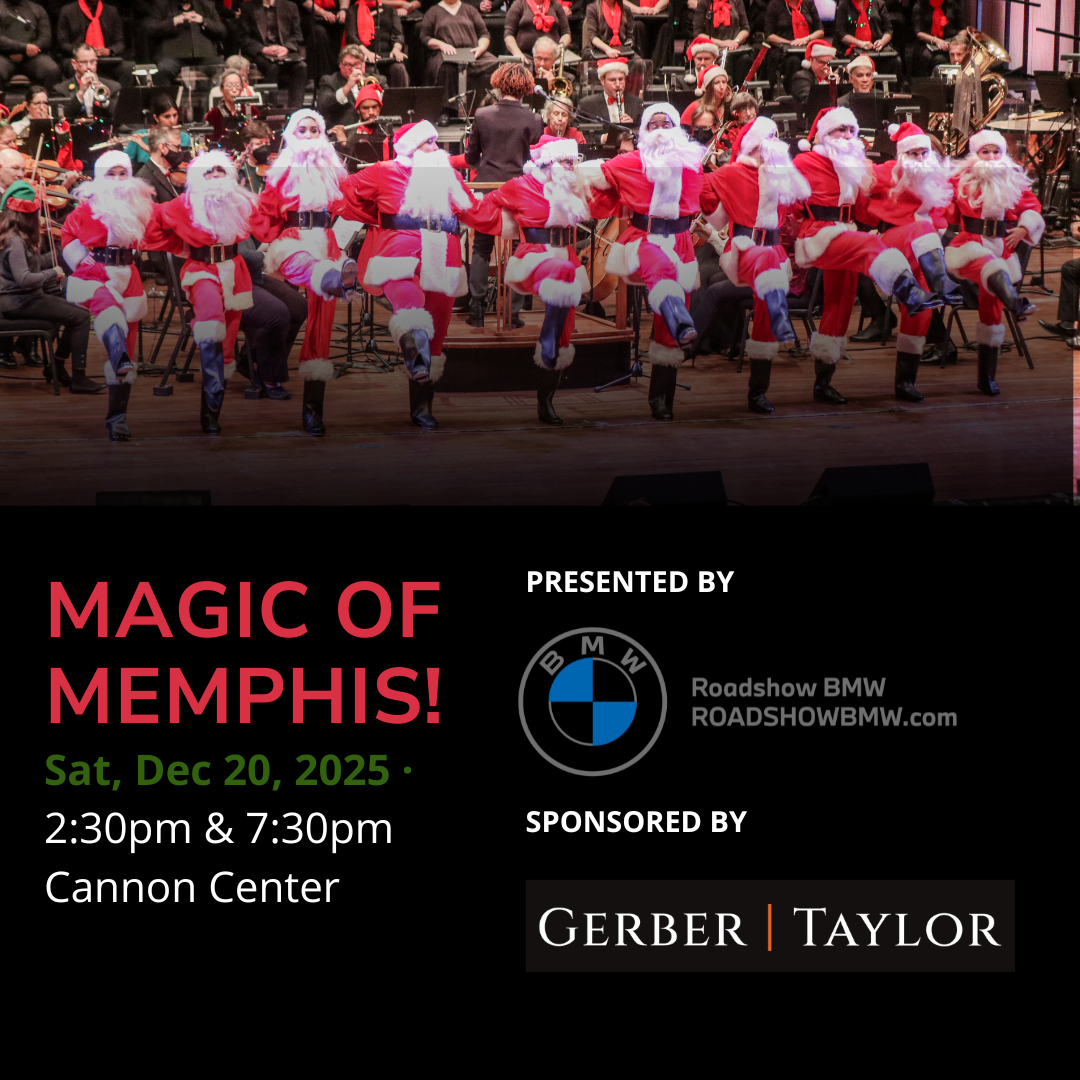SYMPHONIE FANTASTIQUE
Saturday, October 25, 2025 · 7:30pm
Cannon Center for Performing Arts
Sunday, October 26, 2025 · 2:30pm
Scheidt Family Performing Arts Center
Brett Mitchell, conductor
MASON BATES
(b. 1977)
Philharmonia Fantastique
INTERMISSION
HECTOR BERLIOZ
(1803 - 1869)
Symphonie fantastique, op. 14
I. Reveries and Passions: Largo - Allegro agitato e appassionato assai
II. A Ball: Waltz - Allegro non troppo
III. In the Country: Adagio
IV. March to the Scaffold: Allegretto non troppo
V. Dream of the Witches' Sabbath: larghetto - Allegro
Program Notes
-
Mason Bates (b. 1977): Philharmonia Fantastique
First performance: October 2021: Dallas Symphony Orchestra, Maurice Cohn, conductorThe Program Notes for this work are provided by Mason Bates, from his website (www.masonbates.com):
“A truly magnificent achievement…In the art of marrying music with animation, Philharmonia Fantastique is the biggest step forward since Fantasia itself.” – John Williams
“An orchestra tunes – and immediately, a sense of anticipation and wonder ripples through the room. As this super-instrument brings its marvels of engineering together into a single pitch, we are witnessing both art and science. The same orchestra that explores our emotional depths is also our finest example of interactive technology.
The ‘making of the orchestra’ that has occurred over centuries continues into the present day with Philharmonia Fantastique, a concerto for orchestra and animated film. Only recently in its spectacular evolutionary history has the orchestra incorporated digital sounds and projection screens, offering the perfect medium for a kinetic exploration of musical instruments and how they work. Guided by a mercurial Sprite, we fly inside a flute to see its keys up close; jump on a viola string to activate the harmonic series; and zip through a trumpet as its valves slice shafts of air.
Inspired by a desire to offer my own kids a fresh guide to the orchestra, the piece was created with director Gary Rydstrom and animator Jim Capobianco during visits to Skywalker Ranch, George Lucas’s campus of creativity north of San Francisco. With their extensive film experience – Gary won Oscars for his dinosaur sounds in for Jurassic Park, Jim wrote the story for Pixar’s Ratatouille – they helped solve many of the film’s unique puzzles: namely, how to introduce the many facets of the orchestra without using words.
Sometimes accompanying me to the Ranch were my kids and a posse of their friends, playing the role of a slightly suspicious focus group. They responded best to an exuberant piece of art, not a didactic piece of pedagogy, that has elements of mystery and darkness. Equally important is the Sprite, whose journey of self-discovery brings a crucial emotional angle to the story. The Sprite is formed in the work’s opening minutes from a primordial soup of abstract animation, with its arms and legs representing the four ‘families’ of the orchestra: woodwinds, strings, brass, percussion. Represented by a simple yet harmonically wandering piano melody, the Sprite soon dives into the orchestra to explore the instruments from the inside out.
Each family speaks its unique language: noir-ish jazz for the woodwinds; bending lyricism in the strings; dark techno for the brass; and drum-corps in the percussion. Having presented themselves separately, their attempt to play together fails so spectacularly that the Sprite shatters back into the primordial darkness. Only through learning each other’s languages do the different instrument families – as different as the races on earth – fuse together to resurrect the Sprite and become The Orchestra, one of the greatest human creations.”
The instrumentation for Philharmonia Fantastique includes a full woodwind section including several auxiliary family members, full brass, timpani, percussion, harp, piano, celesta, and strings.
Hector Berlioz (1803-1869): Symphonie fantastique, Op. 14
First performance: December, 1830: Paris Conservatoire, François-Antoine Habeneck, conductor.One of the earliest examples of what came to be known as program music, Hector Berlioz’s quasi-autobiographical Symphonie fantastique has been capturing and holding the imagination of audiences since its premiere nearly 195 years ago. Dedicated to Tsar Nicholas I of Russia, the work was inspired by the composer’s love for (obsession with??) Irish actress Harriet Smithson, whom he married in 1833. It is scored for a very large orchestra that includes woodwinds in pairs plus two extra bassoons, a full brass section including cornets and an extra tuba, timpani, percussion, two harps, and strings. One of the most striking things about Symphonie fantastique is the detailed programme that Berlioz provides, and the brilliant manner in which he uses musical gestures to reinforce the imagery: There are six paragraphs that describe the piece—the first being introductory (a series of dreams, visions, and hallucinations brought about as the result of an opium overdose taken due to the despair of unrequited love: Leonard Bernstein entitled his Young Persons presentation “Berlioz Takes A Trip.” That was NOT an accident!!), then one for each of the five movements (the programme was revised twice, once in 1845 and again in 1855: See http://www.hberlioz.com/Scores/fantas.htm?zoom_highlight=Symphonie+fantastique+programme+1855). The idée fixe—the melody representing the beloved (Harriet)—appears in each movement, changing character as the piece progresses, but always recognisable (the instrumentation and/or the rhythm may differ, we may not hear the whole melody as originally depicted—but we ALWAYS get the first eight notes of it!!). Here’s a brief overview of some of the musical gestures to listen for:
I. Reveries, Passions: This movement’s introduction is the slide of our young composer into a quasi-comatose state, recalling “the uneasiness of spirit, the indefinable passion, the melancholy, the aimless joys” he experienced before the beloved one first appeared to him. The idée fixe is then heard for the first time (violins and flute) as he recalls his sudden love, his anguish and jealousy, his tenderness, his religious consolation.
II. A Ball: “In the midst of a brilliant festival, he encounters the loved one again.” This movement’s introduction is based on the waltz, possibly the most popular dance of the 19th century, and features two harps; it is the only movement in which they play. The idée fixe occurs as a secondary theme (oboe), with another fragment (clarinet) reappearing right before the movement’s boisterous conclusion.
III. In The Country: Thoughts of love and hope are first highlighted by a pair of shepherds calling across the fields to each other in a ranz des vaches, a beautiful duet between the English horn and the oboe (the latter is offstage to give a sense of the distance between the two). Sadly, his sense of disquiet returns as he wonders if she will remain faithful: It is at this point that we hear phrases of the idée fixe (oboe) alternating with an agitated countermelody (cellos and double basses, eventually joined by the violas). He eventually calms down, and the English horn resumes the movement’s opening melody. But, instead of the original duet, we hear a thunderstorm gathering in the distance (two sets of timpani in alternation), and the movement ends with a sense of foreboding, “…solitude…silence…”
IV. March To The Scaffold: He dreams that he has murdered his beloved, and has been tried, convicted, and condemned for the crime. This is the march to his place of execution (in France at this period in history, the means of execution would have been the guillotine). Lots of interesting scoring here: A downward scale passage (cellos and double basses, with a countermelody highlighted by FOUR bassoons) alternates with a brass fanfare. The place of execution is reached, and he has one last thought of his beloved (the opening eight notes of the idée fixe, played by the clarinet), before the death blow (loud chord in the orchestra), and the bouncing of the head as it hits the ground (pizzicato lower strings). Justice has been served,…
V. Dream of a Witches’ Sabbath: If there’s a “Halloween” movement, it’s this one!! He dreams of his funeral—which is being attended by all matter of horrid creatures (I always think of the Three Witches from Macbeth at the opening!!),…and guess who turns out to be one of the “guests” in attendance?? It is SHE (his beloved), represented by the idée fixe (E-flat clarinet), which is no longer “noble and shy,” but has been transformed into a “trivial, vulgar and grotesque” dance tune!! Soon, the funeral bells toll, and we hear the Dies irae (Day of Wrath: first played by the bassoons, tubas, cellos and double basses, then repeated in a brass chorale,…and then parodied by the upper woodwinds and pizzicato upper strings in what will become the rhythm of the Witches Dance!!). [I’m sure the church fathers had plenty to say about Berlioz’s use of the Dies irae (the traditional plainchant used in the Roman Catholic Mass for the Dead) in this piece—especially the Witches Dance parody!!]. The last half of the movement is a fugue based on the Witches Dance, which is eventually combined with the Dies irae. At one point in the proceedings, the upper strings are required to bounce their bows on the string instead of using the hair (col legno—with the wood); this represents the dancing skeletons!!
On Stage
-
Hailed for presenting engaging, in-depth explorations of thoughtfully curated programs, American conductor Brett Mitchell is in consistent demand on the podium at home and abroad. In March 2024, he was named Music Director of the Pasadena Symphony, beginning an initial five-year term with the 2024-25 season. He has also served as Artistic Director & Conductor of Oregon’s Sunriver Music Festival since 2022.
In May 2025, with less than 24 hours’ notice, Mr. Mitchell stepped in for his subscription debut with the New York Philharmonic, leading three performances of Kevin Puts’s The Brightness of Light featuring soprano Renée Fleming and baritone Rod Gilfry, followed by the complete score of Ravel’s Daphnis et Chloé featuring the New York Philharmonic Chorus.
Working widely as a guest conductor, Mr. Mitchell’s other recent engagements have included appearances with the Dallas, Detroit, Edmonton, Fort Worth, Houston, Indianapolis, Milwaukee, National, North Carolina, Oregon, San Antonio, San Francisco, Tulsa, and Vancouver symphonies; the Los Angeles Philharmonic at the Hollywood Bowl; the Cleveland and Minnesota orchestras; the Rochester Philharmonic Orchestra; the River Oaks and Saint Paul chamber orchestras; the Grant Park Festival Orchestra; and a two-week tour with the New Zealand Symphony Orchestra. Mr. Mitchell also regularly collaborates with the world’s leading soloists, including Yo-Yo Ma, Renée Fleming, Itzhak Perlman, Kirill Gerstein, Conrad Tao, Rudolf Buchbinder, James Ehnes, Augustin Hadelich, Leila Josefowicz, and Alisa Weilerstein.
From 2017 to 2021, Mr. Mitchell served as Music Director of the Colorado Symphony in Denver; he previously served as Music Director Designate during the 2016-17 season. During his fiveseason tenure, he is credited with deepening the orchestra’s engagement with its audience via in-depth demonstrations from both the podium and the piano. He also expanded the orchestra’s commitment to contemporary American repertoire—with a particular focus on the music of Mason Bates, Missy Mazzoli, and Kevin Puts—through world premieres, recording projects, and commissions. In addition, Mr. Mitchell spearheaded collaborations with such local partners as Colorado Ballet, Denver Young Artists Orchestra, and El Sistema Colorado. In summarizing his tenure, The Denver Post wrote that “Mitchell has been a bright and engaging presence over the years, delving into the history of certain well-worn pieces while leading expert renditions of them.”
From 2013 to 2017, Mr. Mitchell served on the conducting staff of The Cleveland Orchestra. He joined the orchestra as Assistant Conductor in 2013, and was promoted to Associate Conductor in 2015, becoming the first person to hold that title in over three decades and only the fifth in the orchestra's hundred-year history. In these roles, he led the orchestra in several dozen concerts each season at Severance Hall, Blossom Music Center, and on tour.
From 2007 to 2011, Mr. Mitchell led over one hundred performances as Assistant Conductor of the Houston Symphony. He also held Assistant Conductor posts with the Orchestre National de France, where he worked under Kurt Masur from 2006 to 2009, and the Castleton Festival, where he worked under Lorin Maazel in 2009 and 2010. In 2015, Mr. Mitchell completed a highly successful five-year appointment as Music Director of the Saginaw Bay Symphony Orchestra, where an increased focus on locally relevant programming and community collaborations resulted in record attendance throughout his tenure.
As an opera conductor, Mr. Mitchell has served as music director of nearly a dozen productions, principally at his former post as Music Director of the Moores Opera Center in Houston, where he led eight productions from 2010 to 2013. His repertoire spans the core works of Mozart (The Marriage of Figaro and The Magic Flute), Verdi (Rigoletto and Falstaf), and Stravinsky (The Rake's Progress) to contemporary works by Mark Adamo (Little Women), Robert Aldridge (Elmer Gantry), Daniel Catán (Il Postino and Salsipuedes), and Daron Hagen (Amelia). As a ballet conductor, Mr. Mitchell most recently led a production of The Nutcracker with the Pennsylvania Ballet in collaboration with The Cleveland Orchestra during the 2016-17 season.
In addition to his work with professional orchestras, Mr. Mitchell is also well known for his affinity for working with and mentoring young musicians aspiring to be professional orchestral players. His tenure as Music Director of the Cleveland Orchestra Youth Orchestra from 2013 to 2017 was highly praised, and included a four-city tour of China in June 2015, marking the orchestra’s second international tour and its first to Asia. Mr. Mitchell is regularly invited to work with the talented young musicians at this country’s high-level training programs, such as the Cleveland Institute of Music, the National Repertory Orchestra, Texas Music Festival, Sarasota Music Festival, and Interlochen Center for the Arts. He has also served on the faculties of the schools of music at Northern Illinois University (2005-07), the University of Houston (2012-13), and the University of Denver (2019, 2022-23).
Born in Seattle in 1979, Mr. Mitchell holds degrees in conducting from the University of Texas at Austin and composition from Western Washington University, which selected him as its Young Alumnus of the Year in 2014. He also studied with Leonard Slatkin at the National Conducting Institute, and was selected by Kurt Masur as a recipient of the inaugural American Friends of the Mendelssohn Foundation Scholarship in 2008. Mr. Mitchell was also one of five recipients of the League of American Orchestras’ American Conducting Fellowship from 2007 to 2010.
For more information, please visit brettmitchellconductor.com.
Memphis Symphony Orchestra
-
Barrie Cooper, Concertmaster
The Joy Brown Wiener Chair
Marisa Polesky, Assistant Concertmaster
Diane Zelickman Cohen, Assistant Principal
Wen-Yih Yu, Assistant Principal
Long Long Kang
Priscilla Tsai
Jordan Musgrave
Daniel Gilbert
Carissa Perez
Martin Palacios
Ana Maria Trujillo -
Erin Kaste, Principal
The Dunbar and Constance Abston Chair
Lenore McIntyre, Assistant Principal
Yennifer Correia, Assistant Principal
Ann Pretzer
James Ryan
Miguel Lesmes
Alexandre Negrao
Janaina Fernandes
Dario Olivera
Janet Cooper -
Jennifer Puckett, Principal
The Corinne Falls Murrah Chair
Michelle Pellay-Walker, Assistant Principal
Beth Luscombe, Assistant Principal
Michael Brennan
Rossana Cauti
Elizabeth Boardman
Lenny Schranze
Matthew Finley -
Ruth Valente Burgess, Principal
The Vincent de Frank Chair
Iren Zombor, Assistant Principal
Jonathan Kirkscey, Assistant Principal
Jeffrey Jurciukonis
Hannah Schmidt
Mark Wallace
Estefan Perez
Christine Sears
Alisha Rufty -
Chris Butler, Principal
Sean O’Hara
Andrew Palmer
Jeremy Upton
Tiffany Freeman
Tony Smith -
Shantanique Moore, Principal
The Marion Dugdale McClure Chair
Delara Hashemi
Kelly Hermann -
Lani Smith, Principal
The Paul and Linnea Bert Chair
Saundra D’Amato
Shelly Sublett -
Andre Dyachenko, Principal
The Gayle S. Rose Chair
Rena Feller
Nobuko Igarashi -
Susanna Whitney, Principal
The Carolyn Horrell Heppel Chair
Michael Scott
Chris Piecuch
Tina Hazell -
Scott Moore, Principal
The Smith & Nephew Chair
Elizabeth Carter -
Caroline Kinsey, Principal
The Morrie A. Moss Chair
Robert Patterson
Jeremiah Frederick
Leander Star -
Greg Luscombe, Principal
Mark Soueidi
Mark Vail -
Zack Corpus, Principal
The Charles and Sharen Schulz Chair
Alexander Tran -
Ed Murray, Principal
-
David Carlisle, Principal
Bill Shaltis
Stewart Plumlee
Brian Graiser -
Frances Cobb Kenney, Acting Principal
The Ruth Marie Moore Cobb Chair
Colleen Thorburn -
Adrienne Park, Principal
The Buzzy Hussey and Hal Brunt Chair
Legacy gifts help ensure that the Memphis Symphony Orchestra continues to inspire and enrich our community for generations to come. This weekend, we remember our dear friend, Adrienne Davis.






